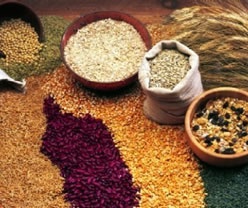
Continuing a decade-long increase, global food prices rose 2.7 percent in 2012, reaching levels not seen since the 1960s and 1970s but still well below the price spike of 1974.
The price increases reverse a previous trend when real prices of food commodities declined at an average annual rate of 0.6 percent from 1960 to 1999, approaching historic lows, according to Worldwatch Institute's Vital Signs Online service.
Along with higher price levels, volatility has also increased dramatically in recent years. According to the United Nations Food and Agriculture Organization (FAO), the standard deviation—or measurement of variation from the average—for food prices between 1990 and 1999 was 7.7 index points, but it increased to 22.4 index points in the 2000–12 period.
Although food price volatility has increased in the last decade, it is not a new phenomenon. According to World Bank data, the standard deviation for food prices in 1960–99 was 11.9 index points higher than in 2000–12.
Some price volatility is inherent in agricultural commodities markets, as they are strongly influenced by weather shocks.
But the recent upward trend in food prices and volatility could be traced to additional factors including climate change, an increase in biofuels production, higher-than-normal imports, trade policies, low levels of stocks, rising energy and fertilizer prices, and increased trade within futures markets for food commodities.
International food price trends (measured in terms of consumer prices, not those paid to producers) varied by commodity in 2012.
Due to the ubiquity of corn, wheat, and rice in global diets, changes in the price of cereal grains generally affect consumers more than fluctuations in other foods.
Since food prices began increasing in the early 2000s, cereal prices have jumped more than 80 percent and exhibited significant volatility, according to the FAO.
Continuing this trend, global cereal prices increased 12.3 percent in 2012. Unfavorable weather conditions including severe drought in the United States and Eastern Europe, drove cereal prices up 18.2 percent between June and September when they approached the all-time high observed in 2008.
Various forces affecting global food supply and demand have influenced the level and volatility of food prices in the last decade.
Population growth and increasing affluence, predominantly in Asia, have led to rising food demand since 2000, which in turn has triggered higher global food prices.
Between 2000 and 2010, Asia’s population grew 12 percent from 3.7 billion to 4.2 billion, and in 2010 Asians accounted for 60 percent of the world’s population. In South Central and Southern Asia, population increased by 16.5 percent and 16.7 percent respectively.
Meanwhile, wages nearly doubled in Asia from 2000 to 2011, whereas they increased only 18 percent in Africa and 15 percent in Latin America and the Caribbean.
Other factors that affected global food prices in the last decade include an increase in bio-fuels production, higher-than-normal imports, trade policies, low levels of stocks, rising energy and fertilizer prices, and increased trade within future markets for food commodities.